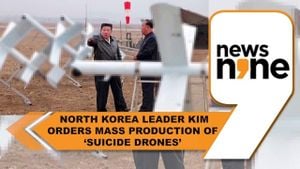The conflict between Russia and Ukraine has morphed with alarming dynamism, particularly evident through recent drone strikes and military engagements. This cat-and-mouse game has seen both sides employing increasingly advanced UAV technologies to gain the upper hand, severely impacting military strategies and the civilian populace caught in the crossfire.
On November 15, 2024, Ukraine launched drones targeting the Krasnodar Krai region of southern Russia, with primary focus on the Krymsk military airfield. Sergey Les, the head of Krasnodar's Krymsky district, confirmed the neutralization of 46 drones over his district, highlighting the intensity of the situation. Fortunately, he stated there were no civilian casualties resulting from the attack, though local areas experienced some damage due to falling debris.
Responding to this incursion, Russian authorities reported their air defense units intercepted 51 UAVs attempting to penetrate its airspace, boosting the air defense narrative and showcasing the struggle to maintain control over aerial dominance. Russian Ministry of Defense specified intercepts occurred predominantly over Krasnodar Krai, with additional engagements reported over Crimea and Belgorod Oblast.
Interestingly, the Krymsk military airfield is notable for housing various aircraft, including Su-27 and Su-30 fighter jets, enhancing its strategic importance. This airfield has garnered attention recently for reasons outside of combat; earlier this year, a Russian Su-30SM fighter jet stationed there was reported missing over the Black Sea, raising eyebrows about the facility's operational security.
This incident points to broader operational challenges faced by both armies, who are adapting to rapid changes on the battlefield. Drone warfare has become emblematic of this evolution, as highlighted by the waves of Ukrainian drones seeking to wreak havoc behind enemy lines. Yet, Western allies remain hesitant about permitting Ukraine to engage deeply within Russian territory. Citing concerns of escalation, they are cautious about endorsing elements of military strategy aimed at eliminating threats closer to home.
Andrii Sybiha, Ukraine’s Foreign Minister, conveyed optimism during discussions with U.S. Secretary of State Antony Blinken. The pair touched upon long-range strikes and the continued pursuit of NATO membership for Ukraine—topics rife with geopolitical significance. Ukraine's insistence on conducting deep strikes within Russian territory reflects its desperate need to alter the dynamics on the front, especially as winter sets in and conditions for ground maneuvers diminish.
Meanwhile, the broader trend at play reflects the strategic necessity of employing drones to augment traditional military tactics. Footage captured from social media showcased dramatic scenes of explosions following the drone strikes—a stark reminder of the human element at play. Videos circulating online depicted the chaotic aftermath of drone attacks, highlighting the direct impacts on not just military installations but potentially on civilian life.
The complexity surrounding the conflict is exemplified through the contrasting narratives from both sides, each vying to maintain not only real estate but also the morale of their people. The use of drones, whether for reconnaissance, defensive measures, or direct strikes, has increasingly shaped the operational scope of military engagements. And as both nations adapt, the race is on to develop faster, more capable drones to support their respective strategies.
Beyond direct military engagements, the impact of the drone warfare extends to the diplomatic arena. Each strike has the potential to reshape alliances and alter perceptions among Ukraine’s Western allies. The reliance on drones has showcased their effectiveness as both deterrent tools and instruments of direct action, yet this still could lead to tug-of-war dynamics among NATO members, who are reluctant to escalate military support for fear of igniting broader conflict.
Both nations are acutely aware of the stakes, and with winter approaching, the struggles to maintain momentum are palpable. While the Russian military has fortified its air defense measures and expanded counter-drone technologies, Ukraine continues pressing against these defenses with increasingly bold drone operations. The interplay of aerial tactics reflects larger strategic assessments, as the conflict favors technology-driven engagements.
Ukrainian President Volodymyr Zelenskyy has been vocal about the need for enhanced military capabilities from allies to contend with Russia's larger arsenal and its persistent attempts to undermine Ukrainian sovereignty. His appeals for long-range capabilities underline the shifting dynamics of warfare, where aerial power is continually becoming more pivotal. Yet, any discussion of long-range strikes remains weighed down by the prospect of inflaming diplomatic tensions.
Looking at the broader global security framework, reactions to these developments will likely influence international policies. The conflict, which began with the annexation of Crimea and has morphed significantly since 2022, continues to reverberate beyond regional boundaries, drawing attention from interested global parties trying to forecast potential shifts and alignments.
What remains evident is the ever-increasing prominence of drone warfare as not only central to this conflict but representative of modern warfare's evolution. With advancements continuing at breakneck speed, the lessons learned here may set precedents for future engagements on global scales.
Analysts caution, though, against viewing any military tactic as purely advantageous; new strategies may require adjustments as battle lines shift and unforeseen complications arise. Every drone sent aloft carries not just technical specifications but the weight of expectation and consequence as the Russian-Ukrainian standoff enters another fraught chapter.
Importantly, this conflict showcases how modern warfare transcends traditional borders and protocols, challenging existing understandings of engagement rules. The indiscriminate nature of drone warfare raises ethical questions about civilian safety and military conduct exceptions, pushing both local populations and international bodies to reconsider how warfare is conducted and regulated.
Each response on either front may inform the next rounds of engagement, propelling this military confrontation with dire consequences, where interpretations of defense and aggression continuously blur. The aerial battles circulating over both Ukrainian and Russian territories remain emblematic of the deteriorated trust and rising tensions influencing future diplomatic efforts.
So, as drone warfare evolves at breakneck speed, how both militaries respond will be imperative for shaping the next leg of this enduring conflict. The capacity to disrupt, dominate, and deter through drone technology will potentially define the future of military strategy not just for Ukraine and Russia, but for conflicts worldwide.



